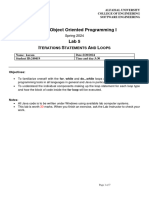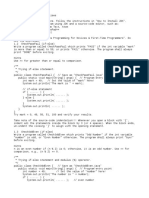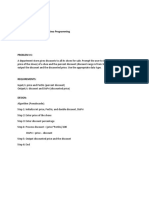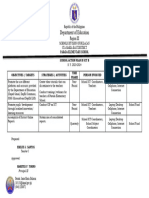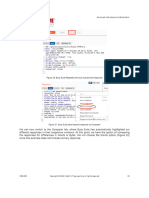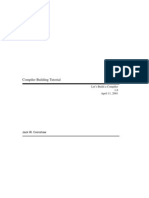Chapter Three: Thinking Concurrently
do – while Loop
Apart from the for – loop there are two other ways of repeating. One is the do – while loop. This
tests its expression at the end of the loop and if it is true, then the loop will continue.
do
{ statements
...
} while ( expression );
public static void main(String args[])
{ int x;
do
{ x = IBIO.inputInt("enter a number less than 100 ");
} while (x >= 100);
IBIO.output("thank you");
}
In this example the program will continue to ask for a number if you type in a number larger than
100.
Pr 3.1 Change the program so that it only accepts numbers that are even and are larger than 0 and less
than 100.
Primes
A prime is a number evenly divisible only by the number itself and one.
public static void main(String args[])
{ int i = 1;
int x = IBIO.inputInt("Enter a number: ");
do
{ i++;
} while (x % i != 0);
IBIO.output(x + " is divisible by " + i);
}
This last program will accept a number and keep dividing it by 2,3,4,5,6, etc. until it finds one
number that goes evenly into it. Note that it will always find one because the number goes into
itself. So if a prime number was input into the program then the output would be that number itself,
or else the output would be the smallest number that goes into it. Note that in the declaration of i it
has also been initialised.
Pr 3.2 Change the last program so that it only accepts numbers that are greater than 1 and outputs the
word prime if indeed the number is prime and otherwise outputs the smallest prime that goes into
the number.
One useful way of testing your program is to put the main part into an infinite while loop.
do
{
// main part of program to test here
} while ( true );
�Digit sum
Given any number the following program will add up the digits in that number. So if 345 was
entered, the program would calculate 3+4+5 = 12. It would start with n = 345, then it would divide
345 by 10 and write down the remainder, which is 5, then it would divide 345 by 10. Because we
are dealing with whole numbers it would get a whole number answer and write down 34. This
process continues until there are no more digits left in the number.
public static void main(String args[])
{
int sum = 0;
int n = IBIO.inputInt(" enter a number ");
do
{ int digit = n % 10; // get right most digit
sum = sum + digit; // add to units digits
n = n / 10; // make new number
} while ( n != 0);
IBIO.output("the sum of the digits of the number is " + sum);
}
Pr 3.3 Change this program so that it will add up the cubes of the digits of the number. So if the input
number was 345 it would go 33 + 43 + 53.
Pr 3.4 Consider the sequence. If a number was even then the next number would be half of that number,
if the number was not even then the next number would be got by multiplying that number by 3 and
then adding 1. eg if 7 was the starting number then that number is odd so it is multiplied by 3 and 1
added to get 22, 7, 22, 11, 34. This sequence continues until it eventually arrives at 1. Write a
program that will allow you to input a number and then it continues this sequence until it eventually
arrives at 1. I want to know how many steps it takes. Eg starting at 3 the sequence is 3, 10, 5, 16,
8, 4, 2, 1 and that takes 7 steps.
while Loop
This is an alternative way of expressing a loop. In this form, the test is done first, before the
execution of its statements.
while ( expression )
{ statements
...
}
�Chapter Four: Thinking Logically (Switch Statement)
Switch, case, break, default
This is a way of making decisions based on many alternatives. Notice carefully the syntax of the
program below. The switch statement is made, then in brackets after it has the variable that is
examined. Then we must have the alternatives enclosed in { }. Lay out your program the same as
this. Each alternative starts with the word “case”, a number and then the alternative followed by
colon “:”. At the end of each case is the word “break”, which is to stop the program continuing into
the next case statement.
switch ( expression )
{ case value1:
statements
break;
case value2:
statements
break;
etc etc etc
default:
statements
break;
}
public static void main(String args[])
{
int num = IBIO.inputInt("enter a number ");
switch (num)
{ case 1:
IBIO.output("that number was 1");
break;
case 2:
IBIO.output("that number was 2");
break;
default:
IBIO.output("that number was neither 1 nor 2");
}
}
Pr 4.1 Write a program that will let you enter two numbers. Then it will ask you to enter “1” for add, “2” for
multiply, “3” for quit. This will be displayed on the screen like below:
Press: [1] for addition
[2] for multiplication
[3] for quit
public static void main(String args[])
{
int a = IBIO.inputInt("enter first number ");
int b = IBIO.inputInt("enter second number ");
int num;
do
{
//menu and switch in here
} while (num != 3)
}
If none of these are entered then the program will announce an error and ask again for these
possibilities. The program will keep doing this until quit is chosen. Only enter the two numbers
once.
�Pr 4.2 Write a program that will add up the sequence
1*7 + 2*2 - 3*5 + 4*7 + 5*2 - 6*5 + 7*7 + 8*2 - 9*5 + 10*7 + … 1000
Note that the there are three cases. First calculate the remainder when divided by 3. x%3. If the
remainder is 0 then the number gets multiplied by -5, if the remainder is 1 then the number is
multiplied by 7 and if the remainder is 2 then the number is multiplied by 2. (669004)
Labels
The break statement allows the program to exit the current situation (in this case the switch). It is
possible to exit more layers. For example we might have a loop which test alternatives. The
program below will continue to loop until the user has guessed the correct number (in this case 17)
mainLoop : do
{ int num = IBIO.inputInt(“enter a number “);
switch ( num )
{ case 17:
IBIO.output(“correct answer”);
break mainLoop;
default:
IBIO.output(“wrong”);
break;
}
} while (true);
Pr 4.3 Write a program that allows the user to enter a number less than 1000. The program will search for
two numbers that when squared and added together make the number that was input. The
program has two loops. One loop going from 1 to num and the second loop also goes from 1 to
num also. In the loop the program will square the numbers and then add them together to see if
they are the same as the input number. If they are then use the break statement to break out of
both loops. Your output will be the numbers or state that it is impossible.
�Chapter Five: Thinking Abstractly (Decimals)
double
This is a new data type. Up to now we have only been dealing with whole numbers. Any variable
we have used must be declared before we use it.
int n; //n is a variable to contain an integer number
Now we introduce a new data type – “double”. This can be used to represent a decimal number.
public static void main(String args[])
{
double a = inputDouble("enter first number ");
double b = inputDouble("enter second number ");
double num = a / b;
output("division gives " + num);
}
“output” will print the number. You can see that the accuracy is very high.
Sequence
The next program will add the numbers together 1 + 1/3 + 1/9 + 1/27 + 1/81 + … It will add 100 of
these together. Notice important things about this program. “i” must be declared as an integer as it is
used in a “for” statement. The variable “sum” and “term” have both been given descriptive names.
In the program we use each term to calculate the next term.
public static void main(String args[])
{
double term = 1;
double sum = 0;
for (int i = 0; i < 100; i++)
{ sum = sum + term;
term = term / 3;
}
IBIO.output("total is " + sum);
}
Pr 5.1 Write a program that will add up the sequence
1/5 + 1/25 + 1/125 + 1/625 + … for 100 terms. (0.25)
In the example above we used one term to create the next term. For some sequences this is difficult
and it is best to create each new term from scratch as in the next example.
Pr 5.2 Write a program that it adds up the sequence
1/1 + 1/4 + 1/9 + 1/16 + 1/25 + … for 100 terms (1.6348839001848923)
�Alternating Sequence
If we have an alternating sequence then the problem is more complicated. An alternating sequence
is one that the terms alternately add then subtract.
double term = 1;
for (int i = 1 ; i < 10 ; i++)
{ IBIO.output(term);
term = term + 3;
}
This creates a sequence of numbers. 1 , 4 , 7 , 10 , 13 ,…
double term = 1;
int sign = 1;
for (i = 1 ; i < 10 ; i++)
{ IBIO.output(sign * term);
term = term + 3;
sign = sign * -1;
}
This creates a sequence of numbers. 1 , -4 , 7 , -10 , 13
Pi
Pi can be calculated using the formula:
π 1 1 1 1 1
=1− + − + − +. ..
4 3 5 7 9 11
Pr 5.3 Write a program that will add up the sequence discussed above to 10,000 terms. Output 4 times
the answer to get pi. (3.1414926535900345)
π 1 1×2 1×2×3 1×2×3×4
=1+ + + + +. ..
2 3 3×5 3×5×7 3×5×7×9
Pr 5.4 The sequence above is a much quicker way of calculating pi Write a program that will add up the
sequence above to 100 terms. Output double the answer (3.1415926535897922)













